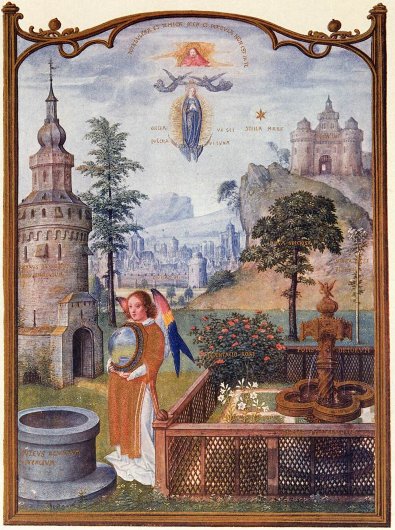|
The Tempest and the Immaculate Conception |
|
|
|
First,
there was the image of the woman crushing the serpent beneath her heel from
Genesis 3:15. The Latin Vulgate gave this passage as, "inimicitias
ponam inter te et mulierem et semen tuum et semen illius ipsa conteret caput
tuum et tu insidiaberis calcaneo eius." "I will put enmity between
thee and the woman, and thy seed and her seed; she shall crush thy head, and
thou shalt lie in wait for her heel." This image first began to appear
in the early 15th century.[i] Secondly,
there was the image of the spouse from the Song of Songs 4:7, "Thou art
all fair my love, and there is no stain in thee." In this image, the
"tota pulchra es," Mary is not a Madonna holding her infant Son,
but a beautiful woman standing alone and surrounded by images from the Old
Testament that symbolize her purity and role. Rona Goffen noted the
prevalence of this image in the devotional literature of the time especially
in the “offices for the feast of the Immaculate Conception by Nogarolis
and by Bernardino de Bustis.”[ii] Finally,
the image of the woman from the Book of Revelation "clothed with the
sun" with "stars in her crown" and standing on the crescent
moon (which would become the standard after the Reformation) began to
appear. These images were rarely used alone but most often in combination.
[PPS 14--Grimani] In the Grimani Breviary, named for the Venetian cardinal
and art collector who was a contemporary of Giorgione's, there is a
miniature of the Woman of the Apocalypse and the "tota pulchra
es."[iii] Interestingly, on the facing page in the Breviary there is an
image of the “Rest on the Flight into Egypt.” [i]For
a discussion of these images see Maurice Vloberg, "The Immaculate
Conception in Art," in The
Dogma of the Immaculate Conception, University
of Notre Dame Press, 1958, pp.463-507. [ii]
Goffen, op. cit. p.149. [iii]The
Grimani Breviary, Levenger Press, DelRay Beach, Florida, 2007, plate 109.
See also, Vloberg, op. cit. plate
XIV.
|
|
|
